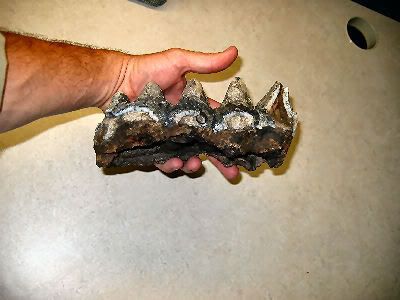
A Grant County trout stream has given up the tooth of a mastodon, an enormous, elephant-like mammal that roamed southwestern and southeastern Wisconsin during the Ice Age.
The 8.5 inch long tooth was discovered earlier this month by a Department of Natural Resources heavy equipment operator working on a trout habitat improvement project. The DNR stopped work upon the discovery, but resumed late last week after being cleared to do so by a state archeologist.
Cale Severson was working on repairing a stream bank washed away by recent flooding and found himself in a "river" of rock scattered around the valley floor. “I noticed something really odd in that pile -- seeing just two of the five cusps (of the tooth) -- and realized it probably was not a rock at that time,” he says. “I grabbed it, and out came the 8.5 inch long molar.”
“It was truly an amazing find and a once in a lifetime opportunity,” says Severson, a longtime member of DNR’s South Central Region’s trout habitat crew.
Severson called regional fishery supervisor Scot Stewart, who stopped work on the project. Work resumed late last week after Wisconsin Historical Society archeologist Sherman Banker examined the site and tooth.
Banker concluded that the find was not significant. No other bones or other artifacts were found near the tooth that might have shed more information on the animal.
“We don’t know where it came from,” says Banker, part of the society’s Division of Historic Preservation. “It got washed out of wherever its primary context was and came to rest on a pile of eroded rock. There is nothing to be learned from it other than it came from a juvenile mastodon.”
However, Banker says, mastodon finds are extremely rare in Wisconsin. “These things usually come to light every 15 to 20 years,” he says. “They have to have died in conditions conducive to being buried so scavengers don’t tear the carcasses a part.”
The remains of a large mastodon found by two children near Boaz in 1897 represent a well known Wisconsin find. The subsequent discovery in 1962 by a UW-Platteville geology professor of two spear points that may have been recovered with the Boaz mastodon created the first substantial evidence in Wisconsin that linked the Paleo-Indians with the hunting of mastodons, according to the Wisconsin Historical Society Web site.
The Boaz Mastodon is on display at the UW-Geology Museum and there is a road marker near where the boys made their discovery.
During the glacial period, mastodons were believed to have roamed over much of North America, from the Gulf of Mexico to New York and northwest to Alaska. Mastodons were smaller than mammoths and similar in size to modern-day elephants, with a height of 7 feet for females or 10 feet for males and a weight of up to six tons, according to the San Diego Natural History museum Web site.
Adult mastodons had molars that featured distinctive, cone-like cusps and gave the animal its name. The word mastodon is derived from the Greek ("mastos" for breast and odon(t) for tooth, according to the Web site.
Mastodons became extinct some time after the last North American ice sheet, and archaeologists do not know whether huge climatic changes around 8,000 years ago doomed the mastodons, or whether, as some have theorized, they were hunted to extinction, Banker says.
source....
No comments:
Post a Comment